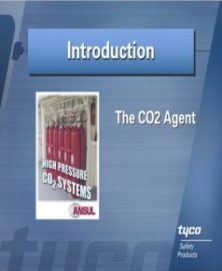TYCO Safety Products co2 fire suppression system
TYCO Safety Products co2 fire suppression system
Carbon Dioxide co2 fire suppression system the original ‘gaseous fire fighting agent used’ in fire protection, is a naturally occurring compound with no measurable environmental impact, making it ideal for non-occupied spaces that can be totally flooded with a gaseous fire suppression system for maximum effect.
Carbon Dioxide is an effective fire extinguishing agent that can be used on many types of fires. It is highly effective in extinguishing deep seated Class A fire risks. Highly versatile, it can flood enclosed areas or be discharged directly onto burning surface fires involving flammable liquids and most solid combustible materials.
It expands at a ratio of 450 to 1 by volume. For fire suppression purposes, the discharge designed to displace the air containing oxygen, which supports combustion, and results in fire extinguishment. It is therefore essential that all person should have Training on CO2 systems to ensure their safety.
You can also Read Aerosol Fire Suppression System Design, Operation & Maintenance Manual
For studying co2 fire suppression system we should know the The CO2 Agent
- Naturally occurring compound
- Closely linked to the life cycle of plantsand animals
- Plant life uses CO2 and Water in Photosynthesis to make Oxygen and Food
![co2 fire suppression system]()
- No Ozone Depletion Potential (ODP)
- No Global Warming Potential (GWP)
- Clear, colorless and odorless
- Doesn’t leave a residue
- Non-corrosive
- Does not react to other materials
- No atmospheric lifetime
- No decomposition products
CO2 – As Extinguishing
- Effective on Class A, B & C
- Extinguishes by OXYGEN DEPLETION
- Provides cooling of fuels
- 1.5 times heavier than air
CO2 The Agent – Application
- Rotating machinery
- Electronic Facilities
- Telecommunications
- Marine Machinery Spaces
- Dust collection areas
- Artifact Facilities
- Turbines
- Oil & Gas Facilities
CO2 Shall not be used to protect:
- Chemical compounds containing their own
- oxygen supply (Gunpowder, Cellulose Nitrate)
- Reactive Metals (Sodium, Potassium,Magnesium, Titanium, Zirconium)
- Metal Hydrides
- Hydrazine or Organic Peroxides


Comments are closed.